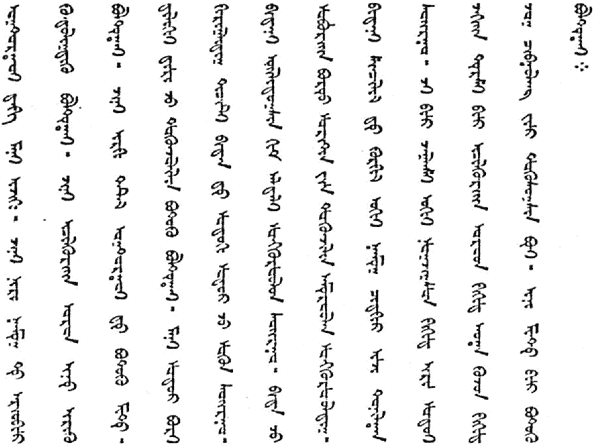Altai under the Dzungarian Khanate
The Altai Republic is situated in the Altai Mountains of southern Siberia and borders Kazakhstan, China and Mongolia. Its native inhabitants are presently known as Altaians, consisting of several peoples of Turkic ethnicity speaking Turkic languages.
The dominant religion of the Altaians was traditionally shamanism, but starting from the beginning of the seventeenth century, they also adopted Buddhism from the Oirats (Altai: Oirot). The Oirats are a Western Mongol people, also called Dzungars, as they lived in Dzungaria, present-day northern East Turkistan (Xinjiang) in China. The Altai region was incorporated into the Dzungarian Khanate (1634 or 1676-1758) in the first half of the seventeenth century, when approximately one-fifth of the Oirat population started their slow migration through the Altai region to the Russian steppes. Some Altai Buddhists joined them in their migration.
The Altaians called the Dzungarian Khanate the Oirot Khanate, and even now they sometimes identify themselves as Oirots, inhabitants of the Oirot Khanate, using this term as a synonym for themselves. Even in the period between 1922 and 1948, when this area was a part of USSR, it bore the name “Oirot Autonomous Region” and the local people were called Oirots, Oirats and even Kalmyks, because the Oirats came to be сalled Kalmyks when they settled in the lower Volga region of the Russian Empire. Much misunderstanding has arisen because of this variety of names.
The Oirats mainly followed the Gelug tradition of Tibetan Buddhism and propagated it among the Altai peoples. In doing so, they persecuted many shamans there. There are stories of how kams (shamans) were burnt alive by Oirat soldiers.
There is much archival evidence that there were lamas in the Altai clans. In some places in Altai, Buddhist statuettes and ritual accessories can still be found and, in the Altai mountains, some old Buddhist images and inscriptions can also be seen. For example, the OM MANI PADME HUM mantra was found on Mount Kut Tuu by the village Bichiktu Boom and also on the cliff bank of the Katun River by the village Yaloman.
It is said that, in the eighteenth century, the Altai Bakshy Boor Aba Kegeen had studied in Tibet for 25 years and even received the academic degree of Geshe. “Bakshy” is Mongolian for a monk teacher and derives from the Sanskrit word “bhikshu,” meaning “monk.” “Kegeen” is the Altai pronunciation of the Mongolian honorific “gegen,” meaning “brilliant one.” “Aba” means father.
The Altai people borrowed or modified several other Mongolian words for Buddhist objects. For example, they used the Mongolian terms süme or khüree for prayer halls, the Mongolian sudur for sutra, ereken for rosaries made of various materials, modified the Mongolian tahil to tagyl for altars, and so on.
During the period of Oirat occupation, the Altaians used the todo bichig (“clear script”) alphabet created by Oirat Zaya Pandita in 1648. Based on the Mongolian vertical script, it more clearly distinguished the various sounds of the language and made it easier than the Mongolian scripts for transcribing Sanskrit and Tibetan words. The todo bichig script is currently being revived in Kalmykia. Even in the middle of twentieth century, there were some people in the Altai region who still knew this alphabet.

Example of the todo bichig script (https://en.wikipedia.org/wiki/Clear_Script)
Altai under Russian Rule
The Altai region was annexed by the Russian Empire in the mid-eighteenth century, with the last southern areas incorporated in 1756. Nevertheless, up to Tarbagatai Treaty of 1864, the Manchu Qing Empire in China also claimed control of this region. After the Russian annexation, Buddhism was considerably weakened by aggressive Russian Orthodox missionaries and by native shamans, who had suffered much persecution during the long Oirat occupation of this area. Nevertheless, it is recorded that the Altai princes (the Zaisans) swore allegiance to Russia by the name of Buddha.
According to old Russian missionary newspapers, Mongolian lamas visited these Altai areas even in 1885 and performed rituals and prayers as requested by local people. In the summer of 1886, the former Zaisan Ochurdyap even became a Buddhist monk. The visits of Mongol kutuhgi (Mong. khutugtu, highly realized lama) and hubulgan (Mong. khubilgan, reincarnate lama) were registered even in 1905 and 1909.
Burkhanism
At the beginning of twentieth century, the Altaians developed their own syncretic religion, “Burkhanism” (from the Mong. borrowed from Uighur: Burkhan, Buddha), combining aspects of Altai shamanism, Tengrism, Buddhism and Orthodox Christianity. As for some of the elements of Buddhism that it included, it rejected, for instance, the bloody sacrifices of the “black faith,” referring to shamanism, and replaced them with an offering of incense and milk products.
The Altaians called Burkhanism the “White Faith” (Ak Jang) to distinguish it not only from shamanism, but also from the “yellow” and “red” schools of Tibetan Buddhism. They believed in the coming messiah-prophet, Oirot Khan, who would be the messenger of the supreme deity, Ak Burkhan (White Buddha). In addition to adapting the name Burkhan (Buddha) for their supreme deity, the Altaians also borrowed from Oirat Buddhism the name of the ruler of the underworld, Erlik (Mong. Erleg, Skt. Yama).
These Burkhanist ideas were soon picked up and supported by Nikolai Roerich (1874-1947), who in 1925 even produced the painting “Oirot – Messenger of the White Burkhan.” He visited Altai, considering it in his Agni Yoga vision as one of the spiritual centers of mankind and, like many others, saw Burkhanism as a form of Buddhism. Many followers of Nikolai Roerich visited Altai, some even relocated there, and contributed to the popularization of Burkhanism among the local intelligentsia. Burkhanism was severely suppressed during the Soviet Stalinist period in the 1930’s.
